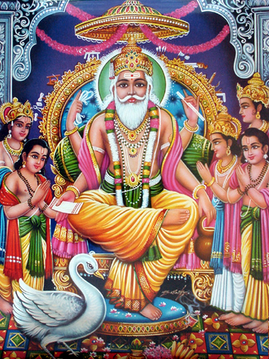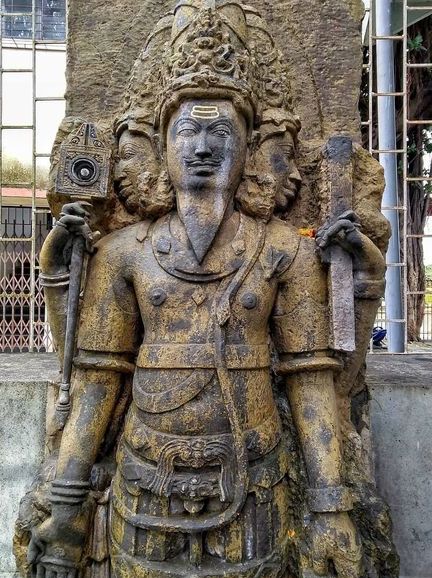
Vishwakarma (also spelled Biswakarma) is a Hindu god of craftsmanship and the architect of gods. He designed and created the palaces, aircraft, and divine weapons of gods. He is also the architect of the universe. There is a Purana called Vishwakarma Purana dedicated to him in which he is regarded as the creator of Lord Brahma, Lord Vishnu, and Lord Shiva. Hindus celebrate his birthday on Kanya Sankranti, which is 16/17/18 September of Gregorian calendar as Vishwakarma Jayanti.
Meaning of the Word Vishwakarma:
The word Vishwakarma comprises of two words, viz. Vishwa (world or universe) and Karma (creator). Therefore, the word Vishwakarma means “the creator of the world”.
The Origin of Vishwakarma:
Lord Vishwakarma has origins in the Rigveda which mentions him as the creator of the universe (earth and heaven). There are two hymns dedicated to him. The concepts of Lord Brahma originating from the navel of Lord Vishnu and the Shiva lingam are based on Vishwakarman Sukta.
But some scholars believe that Vishwakarman in the Rig Veda is an attribute to various gods and not a person. It is also an epithet of to Supreme God, Brahman. Therefore, there is no god named Vishwakarma in the Vedas, but he is a Puranic god.
Following are the two hymns dedicated to him in the Rig Veda.
Book 10, Hymn LXXXI
1. HE who sate down as Hotar-priest, the Ṛṣi, our Father, offering up all things existing,—
He, seeking through his wish a great possession, came among men on earth as archetypal.
2. What was the place whereon he took his station? What was it that supported him? How was it?
Whence Visvakarman, seeing all, producing the earth, with mighty power disclosed the heavens.
3. He who hath eyes on all sides round about him, a mouth on all sides, arms, and feet on all sides,
He, the Sole God, producing earth and heaven, weldeth them, with his arms as wings, together.
4. What was the tree, what wood in sooth produced it, from which they fashioned out the earth and heaven?
Ye thoughtful men inquire within your spirit whereon he stood when he established all things.
5. Nine highest, lowest, sacrificial natures, and these thy mid-most here, O Visvakarman,
Teach thou thy friends at sacrifice, O Blessed, and come thyself, exalted, to our worship.
6. Bring thou thyself, exalted with oblation, O Visvakarman, Earth and Heaven to worship.
Let other men around us live in folly here let us have a rich and liberal patron.
7. Let us invoke to-day, to aid our labor, the Lord of Speech, the thought-swift Visvakarman.
May he hear kindly all our invocations who gives all bliss for aid, whose works are righteous.
Book 10, Hymn LXXXII
1. THE Father of the eye, the Wise in spirit, created both these worlds submerged in fatness.
Then when the eastern ends were firmly fastened, the heavens and the earth were far extended.
2. Mighty in mind and power is Visvakarman, Maker, Disposer, and most lofty Presence.
Their offerings joy in rich juice where they value One, only One, beyond the Seven Ṛṣis.
3. Father who made us, he who, as Disposer, knoweth all races and all things existing,
Even he alone, the deities’ narne-giver, him other beings seek for information.
4. To him in the sacrifice they offered treasures,—Ṛṣis of old, in numerous troops, as singers,
Who, in the distant, near, and lower region, made ready all these things that have existence.
5. That which is earlier than this earth and heaven, before the Asuras and Gods had being —
What was the germ primeval which the waters received where all the Gods were seen together?
6. The waters, they received that germ primeval wherein the Gods were gathered all together.
It rested set upon the Unborn’s navel, that One wherein abides all things existing.
7. Ye will not find him who produced these creatures: another thing hath risen up among you.
Enwrapt in the misty cloud, with lips that stammer, hymn-chanters wander and are discontented.
Similarities Between Tvastar and Vishwakarma:
Most of the qualities that Vishwakarma possesses are attributed to Tvastar in the Vedas.
11 Tvashtar, celestial artist, lay within the body of this dame. A male germ with the noblest form for her in the tenth month to bear.
AV Book 5, hymn 25
But in the Puranas, he is mentioned as the son of Vishwakarma.
The Birth of Lord Vishwakarma:
There are mainly three stories about his birth.
1. When gods and Asuras performed the churning of the ocean, many precious things were born. Vishwakarma was one of those things. The day is known as Vishwakarma Jayanti.
2. Lord Brahma had a son named Dharma who had a son, Vaastu. Vaastu married Angirasi, and from them, Vishwakarma was born.
3. Per the Vishwakarma Purana, he is Swayambhu.
Family:
Father: Vasu Prabhasa (Mahabharata), Vastu (Puranas), seventh Dharmaputra of Lord Brahma.
Mother: Yoga-Siddha, Angirasi.
Wife: Gritachi.
Daughters: Sanjana, Chitragandha, Barhishmati.
Sons: Manu, Maya, Tvastar, Shilpi, Vishwajna, Nala, and Nila.
Son-in-law: Sun.
Vishwakarma Iconography:
Lord Vishwakarma is generally depicted as an old man with a white beard and wearing some jewelry along with a flower garland around his neck. He wears a golden crown on his head and a tripundra on his forehead. He has four hands in which he carries a measuring tape or a measuring scale, Kamandalu, and a book.
Lord Vishwakarma has a close association with Lord Brahma. His Vahana is a swan which is the same as that of Lord Brahma. Some sculptures show him having three or four heads like Lord Brahma. The things that he holds in his hands also vary. These faces look younger in some sculptures and older in others.
Amazing Things Created by Vishwakarma:
1. Vijaya Dhanusa.
2. Pushpaka Vimana.
4. Trishula.
5. Golden Lanka.
6. Dwaraka City.
7. Alakapuri.
8. Heaven.
9. Vajra.
Stories of Vishwakarma:
Creation of Shiva lingam:
Vishwakarma (the architect of gods) stood before a cylindrical shaft to create a sculpture that would be the perfect form of God, but he realized that God cannot be contained in an icon. Therefore, he placed the shaft in a basin and declared this aniconic representation as linga, which means attribute – of that which is formless.
Creation of Weapons of Gods:
Sanjana is the wife of Lord Surya (the Sun god) and the daughter of Vishwakarma. She was finding it difficult to go near her husband because of his heat. She complained about this to her father. He then ground off some of the effulgence of Surya.
Vishwakarma then used that effulgence to create the Sudarshana Chakra of Lord Vishnu, Trishula of Lord Shiva, and other weapons of gods.
Creation of Ravana’s palace:
When Lord Shiva married Goddess Parvati, he asked Vishwakarma to build a beautiful palace for them. overwhelmed by the request of the almighty, he built a golden palace for them. Lord Shiva invited Ravana to perform the Grihapravesh ceremony. After it was over, he asked him anything he would like as Dakshina. Ravana was dumbfounded by the beauty of the palace. So he asked for the golden palace itself. Lord Shiva kept his word and gave it to him.
In another version, Lord Shiva invited Ravana’s father, Pulatsya, to preside over the ceremony and gave him the golden palace as Dakshina. He gave it to Kubera. Afterward, Ravana defeated Kubera and won Lanka.
Creation of Dwaraka:
When Lord Krishna decided to build a city, he invited Lord Vishwakarma to build it. He built it in a day only. The city was so meticulously built that even Lord Krishna could not find a fault in it.
Vishwakarma Puja:
Hindus celebrate Vishwakarma Jayanti to express their gratitude toward the god, Vishwakarma. It falls on Kanya Sankranti. It is the day when the Sun moves from Simha Rashi (Leo) to Kanya Rashi (Virgo). This happens in the month of Bhadrapada every year per the Hindu calendar and on any of the dates from 16-18 September of the Gregorian calendar.
On this day, the people who use any kind of machines or tools, such as engineers, craftsmen, architects, artisans, mechanics, smith, welders, etc., do not work. They clean and worship their tools and machines. They also worship Lord Vishwakarma and ask for his blessings.
Vishwakarma Caste:
There is a separate Hindu community by his name who claim that they are his descendants. It consists of five main sub-groups, viz. carpenters, blacksmiths, bronze smiths, goldsmiths, and stonemasons.
These five groups are descendants of the five sons of Vishwakarma, viz. Manu, Maya, Tvastar, Shilpi, and Visvajna.
Modern Archaeological Instruments in the Hands of Lord Vishwakarma?
In Nalasopara, Mumbai, there is a famous temple by the name of Chakrshwara Mahadev Mandir where there is a statue of Vishwakarma that is about 1000 years old. Interestingly, in the upper right hand of it, there is an instrument that looks like a theodolite. It appears as if a person is looking through it to take measurements.

Image Source: Facebook
A theodolite is a precision optical instrument for measuring angles between designated visible points in the horizontal and vertical planes.
There are other sculptures spread across India that depict him holding a leveler, plumb bob, soil probe, and other instruments that modern engineers use.
Watch this video for more information:
https://www.youtube.com/watch?v=F0Jty1hnzy4&list=LL&index=2&t=623s